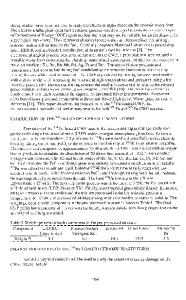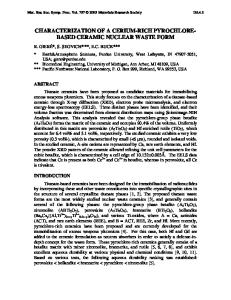Accelerated Alpha Radiation Damage in a Ceramic Waste Form, Interim Results
- PDF / 1,661,558 Bytes
- 6 Pages / 415.8 x 637.2 pts Page_size
- 27 Downloads / 282 Views
and cracking of the material usually has a detrimental affect on the durability of the waste form [6]. Some crystalline materials, however, such as Pu02, U0 2 and ZrO 2 for example, show little damage to the crystalline structure after prolonged radiation exposure [3]. This study wishes to address these issues relating to the CWF. EXPERIMENTAL A detailed description of the processing of the CWF is found elsewhere [7]. The process first involves occluding the salt in dry (< 0.5 wt% moisture) zeolite 4A. The zeolite is then mixed with a glass binder and consolidated at a temperature of 1100 K and a pressure of 34 MPa. During this processing, the zeolite converts to sodalite. The composition of the pre-processed mixture is shown in Table 1. The fission product surrogate salt contains KBr, KI and the chlorides of Na, Rb, Sr, Y, Cs, Ba, La, Ce, Pr, Nd, Sm and Pu. In this study, the CWF was loaded to approximately 2.5 wt% 238pu. This Pu loading is roughly 3 to 20 times the actual Pu (elemental) loading of the CWF produced during the fuel treatment process. After contacting with the zeolite, the Pu converts to the oxide. This conversion is presumably due to the reaction of Pu with oxygen from residual water in the zeolite. Table 1. Weig t percent of each component in the pre-processed mixture. Component LiCI/KCI Fission Product Zeolite 4A Glass binder Elemental Eutectic Salt Surrogate Salt I Pu Weight % 4.1 1.7 64.7 25.0 2.5 The 23Spu-loaded CWF is being analyzed on a periodic basis to evaluate a-decay damage to the waste form. The testing schedule is planned for a minimum of 4 years. The methods used to study the extent of a-decay damage on the CWF are separated into the following sections: 1) Waste form microstructure and elemental distribution is being investigated by scanning electron microscopy (SEM) in conjunction with energy and wavelength dispersive spectroscopy (EDS/WDS). Transmission electron microscopy (TEM), in conjunction with electron diffraction (ED) and EDS, is also being performed. 2) Powder x-ray diffraction (XRD) is used to monitor bulk phase composition and changes to major phase lattice parameters. 3) Density measurements on the CWF are being performed by an immersion method. Density measurements provide information on macroscopic swelling as a function of cumulative dose. 4) Durability of the 238pu-loaded CWF, with cumulated a-decay dose, is compared to the nonradioactive CWF reference material using the PCT-A leach method [8]. The leach test uses a crushed material with a -100 to +200 mesh size fraction, demineralized water for the leachant, and a surface area to volume ratio of 2000 m 1 . Elemental determination of the leachate is performed by inductively coupled plasma-mass spectrometry. RESULTS Microscopy 238 The microstructure (Figures I a and b) of the pu-loaded CWF is very similar to the reference (non-Pu loaded) CWF and consists of 5 to 20-micron diameter sodalite grains surrounded by the glass binder. Plutonium is found primarily as PuO2 in the glass intergranular boundaries between sodalit
Data Loading...











